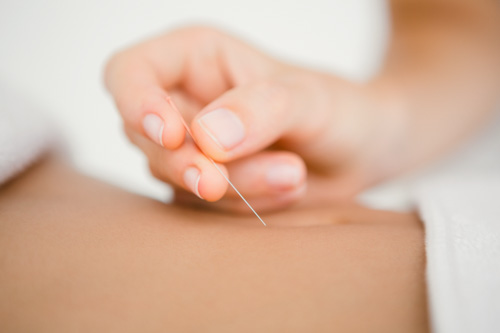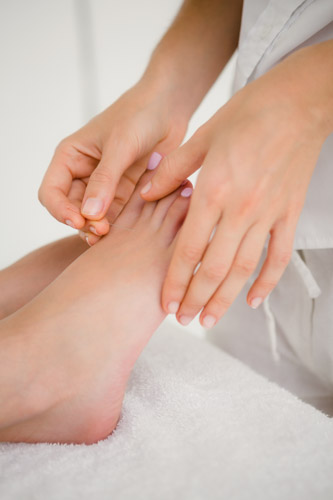Acupuncture and herbal medicine relieve rheumatoid arthritis symptoms. Data also reveals that acupuncture plus herbs reduces inflammatory markers.  In a randomized controlled study, researchers from Anhui University of TCM (Traditional Chinese Medicine) compared the efficacy of acupuncture plus herbs in one study group with drugs in another study group. Acupuncture combined with herbal medicine achieved an 85% total effective rate and drugs achieved a 70% total effective rate. The researchers conclude that acupuncture plus herbs for rheumatoid arthritis is effective, has negligible side effects, lowers inflammatory markers, and significantly relieves symptoms.
In a randomized controlled study, researchers from Anhui University of TCM (Traditional Chinese Medicine) compared the efficacy of acupuncture plus herbs in one study group with drugs in another study group. Acupuncture combined with herbal medicine achieved an 85% total effective rate and drugs achieved a 70% total effective rate. The researchers conclude that acupuncture plus herbs for rheumatoid arthritis is effective, has negligible side effects, lowers inflammatory markers, and significantly relieves symptoms.
Rheumatoid arthritis is a chronic autoimmune inflammatory disorder often affecting the small joints of the hands and feet. Many other areas may be affected including the skin, eyes, vessels, and internal organs. Rheumatoid arthritis affects the lining of the joints and may lead to osseous erosion, severe pain and swelling, range of motion impairment, and joint deformities.
Zhu et al., from the Anhui University of TCM, cited an earlier investigation by Wang et al. finding acupuncture plus external application herbs effective for the alleviation of rheumatoid arthritis. Wang et al. noted that external application herbs are absorbed through the skin and can target specific areas affected by rheumatoid arthritis. Wang et al. note that this enhances treatment efficacy by promoting blood circulation in areas most affected by rheumatoid arthritis.
Acupuncture plus external application herbs were compared with the use of an NSAID (nonsteroidal anti-inflammatory drug), diclofenac. Acupuncture plus herbs produced significantly greater positive patient outcomes than diclofenac in 75 mg sustained released tablet form, once per day for thirty days. The acupuncture plus herbs group received needling chosen from amoung the following acupoints:
- Fengchi, GB20
- Quchi, LI11
- Yangchi, SJ4
- Yangxi, LI5
- Xuehai, SP10
- Heding, M-LE-27
- Yanglingquan, GB34
- Xi Yan, MN-LE-16
- Ashi
Local points were given preference when choosing 10 acupoints for treatment per patient. Mild reinforcing and reducing techniques were applied using lifting, thrusting, and twisting techniques to obtain deqi. Upon arrival of deqi, needles were retained for thirty minutes per session. Acupuncture was administered once per day at a rate of six per week. On the seventh day, no treatment was administered. A total of thirty days comprised one course of care.
The TCM herbal medicine for external application was prepared by levigating it. Once powdered, the formula was mixed with hot water to form a paste and applied to the affected body parts. The herbal paste included:
- Fu Zi
- Xu Duan
- Sang Ji Sheng
- Gou Ji
- Qiang Huo
- Dan Shen
- Gui Zhi
- Hong Hua
- Ru Xiang
The researchers note that the TCM functions for the mixture include promoting blood circulation, dredging the meridians, relieving pain, and reinforcing the liver and kidneys. Acupuncture plus herbs achieved an 85% total effective rate. The NSAID therapy achieved a 70% total effective rate. 
Researchers had similar findings in a study entitled Clinical observation on treating rheumatoid arthritis with the Guizhi Shaoyao Zhimu decoction plus acupuncture. Acupuncture was combined with herbal medicine in a semi-protocolized approach. The study differed from that of Zhu et al. in that the herbs were for oral ingestion and not external application. The medication group received the same NSAID, diclofenac. The dosage was 75 mg, once per day. In addition, the medication group also took methotrexate, 10 mg, once per week.
The acupuncture plus herbal medicine group had an overall effective rate of 95.08% and the drug group had an effective rate of 68.85%. In addition, the adverse side effects associated with the drug group was significant at 18.0% whereas the acupuncture plus herbal medicine group had a 3.2% adverse effect rate. The researchers concluded that acupuncture plus herbs is safer and more effective than NSAIDs plus methotrexate for the treatment of rheumatoid arthritis.
A total of 122 patients with rheumatoid arthritis were randomly divided into an acupuncture plus herbs group and a medication group. The acupuncture plus herbs group received modifications of the herbal formula Gui Zhi Shao Yao Zhi Mu Tang.
The base herbal formula contained:
- Gui Zhi 15g
- Chi Shao Yao 12g
- Zhi Mu 12g
- Fu Zi 10g
- Ma Huang 9g
- Fang Feng 15g
- Bai Zhu 12g
- Gan Cao 6g
For acute symptoms, the protocol included the addition of the following herbs:
- Qin Jiao 12g
- Shen Jin Cao 12g
- Qiang Huo 12g
For chronic symptoms, the protocol included the addition of the following herbs:
- Huang Qi 45g
- Du Zhong 15g
- Niu Xi 12g
For severe pain, the protocol included the addition of the following herbs:
- Yan Hu Suo 12g
- Lu Feng Fang 12g
- Wu Tou 9g
The primary acupuncture point prescription included the following acupoints:
- Jinsuo, DU8
- Sanyinjiao, SP6
- Zusanli, ST36
- Ganshu, UB18
- Shenshu, UB23
- Pishu, UB20
For arm pain, the following acupuncture points were added:
- Tianjing, SJ10
- Waiguan, SJ5
- Yangchi, SJ4
- Hegu, LI4
For leg pain, the following acupuncture points were added:
- Weizhong, UB40
- Dubi, ST35
- Kunlun, UB 60
- Jiexi, ST41
- Yanglingquan, GB34
Huatoujiaji points were added for back pain. Tonifying manual acupuncture techniques were applied to primary acupuncture points. Secondary acupuncture points chosen for specific types of pain received sedating needle techniques. Total needle retention time per session was 30 minutes. Moxibustion was also applied. Acupuncture and moxibustion were applied once every two days for a course of 30 days. The total treatment consisted of two courses of care.
The differences in both effective rates and safety were statistically significant. Based on the data, the researchers conclude that modified Gui Zhi Shao Yao Zhi Mu Tang plus acupuncture is safer and produces better patient outcomes than diclofenac plus methotrexate.
References:
Zhu, Y. (2014). Therapeutic Observation of Acupuncture plus Chinese Medicinal Application for Rheumatoid Arthritis. Shanghai Journal of Acupuncture and Moxibustion. 33(11).
Wang, XJ. (2012). Treatment Efficacy of TCM External Application in Treating Rheumatoid Arthritis. Lishizhen Medicine and Materia Medica Research. 23(10): 2661-2662.
Wang, Zizhen. “Clinical observation on treating rheumatoid arthritis with the Guizhi Shaoyao Zhimu decoction plus acupuncture.” Clinical Journal of Chinese Medicine 6.4 (2014): 89-90.


